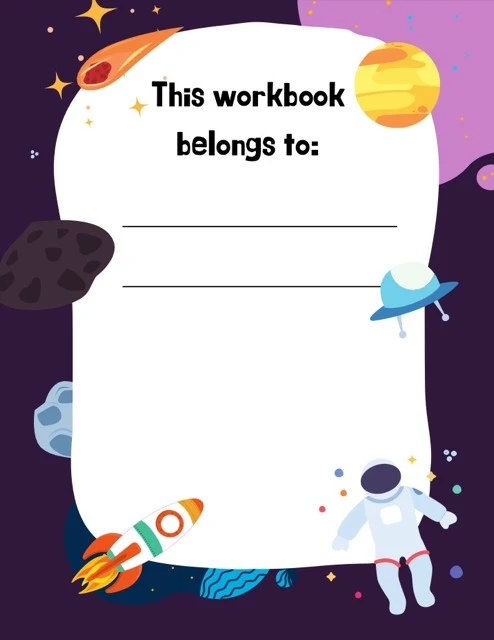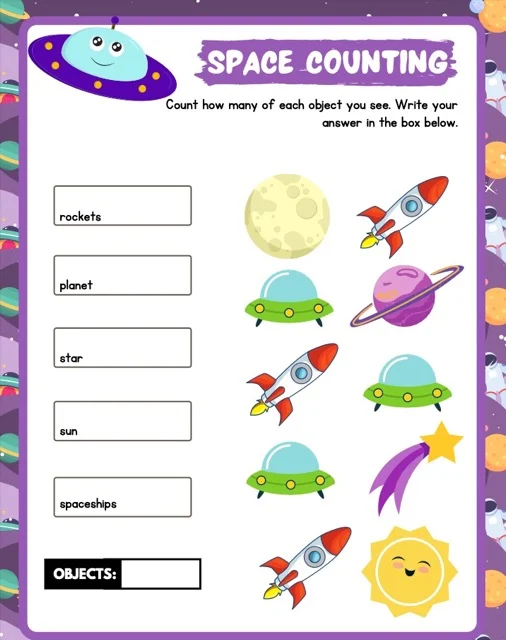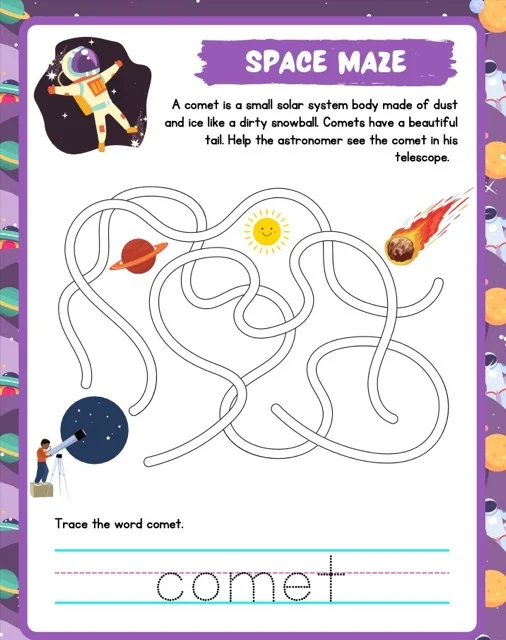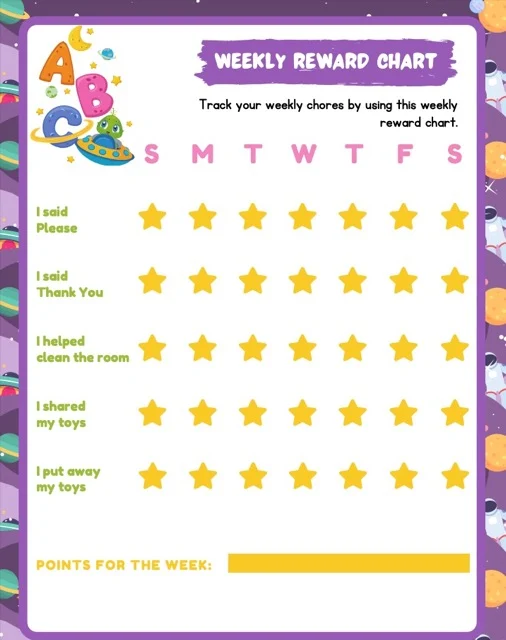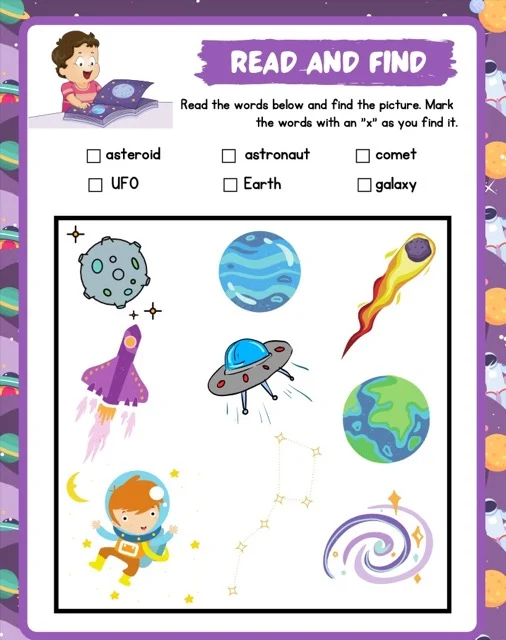Space Activities for Kids: A Review
A briefing document analyzes "Space Activities for Kids," an activity book designed to teach children about space. The book uses diverse activities, such as coloring, mazes, and word searches, to make learning fun and accessible. It focuses on developing multiple skills, including fine motor skills, problem-solving, and creativity, while also building space-related vocabulary. The analysis highlights the book's adaptability for different age groups and learning styles, and suggests its potential to spark children's interest in STEM. Supporting evidence comes from the activity book itself, a study guide, and visual samples. The overall assessment is that the book is a valuable tool for early space education.
Space Activities for Kids: A Learning Analysis
Briefing Document: Space Activities for Kids
Overview: This briefing document analyzes "Space Activities for Kids," an activity book designed to engage children in learning about space. The analysis draws upon excerpts from the activity book itself, its accompanying study guide, and visual samples of the activities.
Main Themes:
●
Engaging & Accessible Space Education: The core theme is to make learning about space enjoyable and accessible for children through a variety of interactive activities. These activities incorporate key space-related vocabulary and concepts, fostering early STEM education.
●
Holistic Skill Development: The book goes beyond space facts, aiming to develop fine motor skills, problem-solving abilities, creativity, and imagination through activities like tracing, coloring, mazes, and open-ended drawing prompts.
●
Adaptability and Differentiation: The activities are designed to be adaptable for different age groups and learning styles, ensuring inclusivity and personalized learning experiences.
Key Ideas & Facts:
●
Diverse Activities: The book features a range of activities, including:
○
Coloring pages of planets, rockets, and astronauts
○
Mazes featuring space-themed challenges
○
Dot-to-dot activities that reveal space objects
○
Word searches incorporating space vocabulary
○
Matching exercises to connect space concepts
○
"Finish the Drawing" prompts to stimulate creativity
●
Vocabulary Building: The activities consistently integrate key space terms like "astronaut," "spaceship," "planet," "rocket," "comet," "alien," and "solar system," exposing children to relevant terminology.
●
Fine Motor Skill Development: The study guide emphasizes how activities like tracing and coloring within lines help refine fine motor skills, which are crucial for tasks like writing and drawing. This is exemplified in activities like "Space Tracing."
●
Problem-Solving & Critical Thinking: Activities like mazes and word searches ("Space Maze" and "Space Tracing") are highlighted for their ability to encourage problem-solving skills by requiring children to think strategically and find solutions.
●
Creativity and Imagination: The "Finish the Drawing" activity, where children complete a spaceship drawing, is specifically lauded for promoting creativity and personalization in learning.
Supporting Quotes:
●
"The activities incorporate key space-related terms such as: Astronaut, Spaceship, Planet, Rocket, Comet, Alien, Solar System." - Space Activities FAQ
●
"Activities like tracing, coloring within lines, and connecting dots enhance fine motor skills." - Study Guide Answer Key
●
"Mazes and word searches encourage problem-solving skills by requiring children to think critically to find solutions." - Study Guide Answer Key
●
"The 'Finish the Drawing' activity fosters creativity by allowing children to use their imagination to complete the picture of a spaceship." - Study Guide Answer Key
Potential Impact:
"Space Activities for Kids" appears to be a valuable tool for introducing young children to the wonders of space in an engaging and multifaceted manner. By combining education, entertainment, and skill development, the book holds the potential to spark curiosity and a lifelong passion for STEM fields.
Space Activities for Kids
Space Activities FAQ
1. What are some ways to engage children in learning about space?
This activity book features a variety of engaging activities designed to make learning about space fun for children. These activities include coloring, mazes, dot-to-dot connections, word searches, and matching exercises.
2. What specific space-related vocabulary can children learn from these activities?
The activities incorporate key space-related terms such as:
●
Astronaut
●
Spaceship
●
Planet
●
Rocket
●
Comet
●
Alien
●
Solar System
3. How do these activities help children develop fine motor skills?
Many activities, like tracing, coloring within lines, and connecting dots, help refine fine motor skills essential for writing and other tasks.
4. Can these activities be adapted for different age groups?
Yes, the activities can be adjusted to suit different age groups. For younger children, focus on simpler tasks like coloring and matching. Older children can engage in more complex activities like mazes, word searches, and pattern completion.
5. How can these activities be incorporated into a classroom setting?
These activities can serve as supplemental learning tools in a classroom. They can be used for individual work, group projects, or even as fun homework assignments.
6. Do these activities encourage problem-solving skills?
Yes, activities like mazes and word searches require problem-solving and critical thinking to find solutions and complete the tasks.
7. How do these activities stimulate creativity and imagination?
Activities like "Finish the Drawing" encourage children to use their imagination to complete the picture of a spaceship. This fosters creativity and allows children to personalize their learning experience.
8. What other benefits do these activities offer?
Besides the educational value, these activities also offer benefits like:
●
Improved concentration and focus: Engaging in focused tasks like tracing and dot-to-dot connections enhances concentration.
●
Stress relief: Coloring and other hands-on activities can be relaxing and therapeutic for children.
●
Increased confidence: Successfully completing activities boosts children's confidence and encourages them to tackle more challenging tasks.
Space Activities for Kids: A Study Guide
Exploring the Cosmos: A Study Guide for Space Activities for Kids
Short-Answer Quiz
Instructions: Answer the following questions in 2-3 sentences.
1.
Identify three specific activities featured in "Space Activities for Kids" and explain how they promote learning about space.
2.
How do the activities in the workbook support the development of fine motor skills in children? Provide examples.
3.
Explain how the activities can be adapted for use with different age groups. Give specific examples.
4.
Describe two ways these space activities can be integrated into a classroom setting.
5.
Beyond educational value, what are two additional benefits children can gain from engaging in these space activities?
6.
How do activities like mazes and word searches encourage problem-solving skills in children?
7.
Explain how the "Finish the Drawing" activity fosters creativity and personalization in a child's learning experience.
8.
What is the purpose of including key space-related vocabulary in the activities?
9.
Name three space-related vocabulary words featured in the workbook.
10.
In your opinion, how effective would these activities be in sparking a child's interest in space exploration? Justify your answer.
Answer Key
1.
The workbook features coloring pages, mazes, and dot-to-dot activities. These activities promote learning about space by incorporating space-themed imagery like planets, rockets, and astronauts. For example, while coloring a rocket, children can learn about its different parts and how it functions.
2.
Activities like tracing, coloring within lines, and connecting dots enhance fine motor skills. These actions require precise hand movements, strengthening hand-eye coordination and dexterity. These skills are essential for tasks like writing and drawing.
3.
The activities can be adapted for different age groups. For younger children, simpler tasks like coloring planets or matching rockets can be introduced. Older children can engage in more complex activities like solving space-themed mazes or completing word searches featuring space vocabulary.
4.
These space activities can be integrated into a classroom setting as supplemental learning tools during individual work time or for group projects. They can also be assigned as fun and engaging homework assignments, reinforcing learning outside of school hours.
5.
Apart from educational value, the activities offer benefits like improved concentration and focus, as engaging in focused tasks like dot-to-dot connections requires attention. Additionally, coloring and other hands-on activities can be stress relieving and therapeutic for children, providing a creative outlet.
6.
Mazes and word searches encourage problem-solving skills by requiring children to think critically to find solutions. In mazes, they must navigate a path, while in word searches, they need to locate specific words hidden within a grid of letters, both activities stimulating logical thinking and strategy development.
7.
The "Finish the Drawing" activity fosters creativity by allowing children to use their imagination to complete the picture of a spaceship. They can personalize their spaceship with unique features, expressing their individual ideas and interpretations. This personalization enhances their engagement and makes the learning experience more meaningful.
8.
Including key space-related vocabulary in the activities exposes children to new terms and concepts associated with space. Repetition and visual association through activities help them learn and remember these words, building their space-related vocabulary.
9.
Three space-related vocabulary words featured in the workbook are "astronaut," "spaceship," and "planet."
10.
These activities can be highly effective in sparking a child's interest in space exploration. The vibrant visuals, engaging formats, and hands-on nature of the activities make learning about space fun and accessible. By fostering curiosity and providing a positive learning experience, these activities can ignite a passion for space in young minds.
Essay Questions
1.
Analyze how "Space Activities for Kids" promotes a holistic learning experience by integrating education, entertainment, and skill development.
2.
Discuss the importance of fostering creativity and imagination in children's learning, using examples from the "Space Activities for Kids" workbook.
3.
Evaluate the effectiveness of using activity-based learning, as presented in the workbook, for teaching children about space.
4.
Explain how "Space Activities for Kids" supports differentiated instruction by catering to different learning styles and age groups.
5.
Discuss the potential impact of early exposure to STEM (Science, Technology, Engineering, and Mathematics) concepts through activities like those featured in the workbook.
Glossary of Key Terms
●
Astronaut: A person trained to travel and work in space.
●
Spaceship: A vehicle designed to travel in outer space.
●
Planet: A celestial body that orbits a star and does not emit its own light.
●
Rocket: A vehicle that uses the thrust from an engine to propel itself, often used for space travel.
●
Comet: A small icy body that orbits the sun and releases gas and dust when it gets close to the sun, creating a visible tail.
●
Alien: A being from another planet or world.
●
Solar System: The collection of planets, moons, asteroids, and other objects that orbit around the sun.
●
Fine Motor Skills: Small, precise movements that use the muscles in the hands, fingers, and wrists.
●
Problem-solving: The process of finding solutions to difficult or complex issues.
●
Creativity: The ability to think of new and original ideas.
●
Imagination: The ability to form mental images or concepts of what is not actually present to the senses.
●
Vocabulary: The body of words used in a particular language or subject.
●
STEM: An acronym for Science, Technology, Engineering, and Mathematics, representing an interdisciplinary approach to education.

